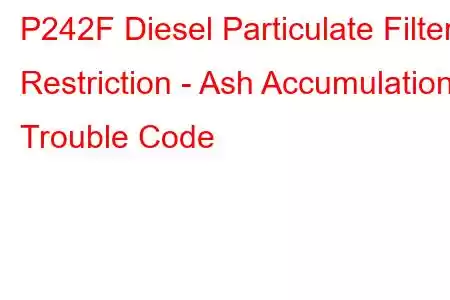P242F Diesel Particulate Filter Restriction - Ash Accumulation
OBD-II Trouble Code Technical Description
Diesel Particulate Filter Restriction - Ash Accumulation
What does that mean?
This diagnostic trouble code (DTC) is a generic powertrain code, which means that it applies to most newer diesel vehicles (Ford, Mercedes Benz, Vauxhall, Mazda, Jeep, etc.). Although generic, the specific repair steps may vary depending on make/model.
On rare occasions, when I have discovered a stored P242F code, it has meant that the powertrain control module (PCM) has detected a level of ash restriction in the diesel particulate filter (DPF) deemed to be restrictive. This code is used exclusively in diesel powered vehicles.
The DPF looks like a muffler or catalytic converter that is protected by a steel, inline exhaust housing. It is located ahead of the catalytic converter and/or the NOx trap. Large soot particles are trapped in the DPF element. Small particles and other (exhaust gas) compounds are allowed to pass through.
The most important part of any DPF is the filtration element. The DPF can be constructed using one of several elemental compounds that trap soot and still allow engine exhaust to pass through. They include paper, metal fibers, ceramic fibers, silicone wall fibers, and cordierite wall fibers. Cordierite is one type of ceramic based filtration compound and the most common type of fiber used in DPF applications. It is inexpensive to manufacture and possesses exceptional filtration characteristics.
As exhaust passes through the element, large particles of soot are trapped between the fibers. When sufficient soot is accumulated, exhaust pressure increases accordingly and the filtration element must be regenerated in order to allow spent exhaust gases to continue flowing through.
Ash accumulation is a side effect of DPF filtration and regeneration. It is caused by the extended use of incombustible materials like lubricant additives, trace elements in diesel fuel/additives, as well as debris from engine wear and corrosion. Ash typically accumulates along the DPF walls or in plugs near the rear of the filtration element. This significantly decreases the effectiveness of the filtration element and dramatically reduces the filter’s soot storage arrangement and capacity.
Because the ash is situated near the walls and rear of the DPF, soot particles are forced to the front, effectively reducing channel diameter and filter length. This can result in increased flow velocity (through the DPF) and a resultant increase in the output signal voltage of the DPF pressure sensor.
When the PCM detects these notable variations in DPF flow, velocity, or volume, a code P242F will be stored and a malfunction indicator lamp (MIL) may be illuminated.
Severity & Symptoms
The conditions for causing the code P242F to be stored may cause internal engine or fuel system damage and should be addressed with haste.
Symptoms of a P242F code may include:
Diminished engine performance Excessive black smoke from the exhaust Higher engine temperatures Higher transmission temperaturesCauses
Possible causes for this engine code include:
Excessive ash accumulation in the DPF Defective DPF pressure sensor Clogged DPF pressure sensor tubes/hoses Open or shorted circuit/s in the DPF pressure sensor circuit Inefficient DPF regeneration Overuse of engine and/or fuel system additivesDiagnostic and Repair Procedures
A good starting point is always to check for technical service bulletins (TSB) for your particular vehicle. Your issue may be a known issue with a known fix put out by the manufacturer and can save you time and money during diagnosis.
A diagnostic scanner, a digital volt/ohmmeter, and a reliable vehicle information source (I use All Data DIY) will be necessary when diagnos
Read: 25


